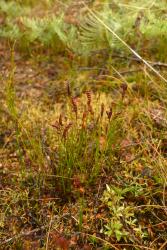- = Ripidium Bernh., J. Bot. (Schrader) 1800(2): 127 (1801)
- = Microschizaea C.F.Reed, Bol. Soc. Brot. Ser. 2 21: 133 (1948)
As for the family, except: sterile portions of the frond terete or flattened; modified fertile portions, at the distal end of the undivided or dichotomously branching sterile portions, pinnately branched; branches of the fertile portions short and infolded.
A genus of c. 15 species (when distinguished from Actinostachys).
| 1 | Sterile portion of the frond dichotomously branching 1–7 times | 2 |
| Sterile portion of the frond undivided | 3 | |
| 2 | Sterile portion of the frond flattened, glossy and smooth, dividing 3–7 times; fertile portions of the frond 2–8 mm long | dichotoma |
| Sterile portion of the frond ±terete, dull and often scabrid, dividing 1–2 or rarely 3 times; fertile portions of the frond 5–24 mm long | bifida | |
| 3 | Sterile portion of the frond often scabrid; branches of fertile portions 3–13 mm long; hairs present amongst the sporangia | bifida |
| Sterile portion of the frond smooth; branches of fertile portions 2–7 mm long; hairs absent between the sporangia | 4 | |
| 4 | Sterile portion of the frond 15–345 mm long; fertile portion of the frond 3–17 mm long; branches of fertile portions in 4–13 pairs; stomata on sterile portion of frond 81–114 μm long; plants of montane or southern and subantarctic areas | australis |
| Sterile portion of the frond 100–550 mm long; fertile portion of the frond 9–38 mm long; branches of fertile portions in 7–30 pairs; stomata on sterile portion of frond 126–180 μm long; plants of lowland areas | fistulosa |
Schizaea has very characteristic fronds with very short, pinnately branched fertile portions at the distal end of long, undivided or dichotomously branched, sterile portions. The fertile branches are infolded in the form of a comb, and the sori are borne individually in marginal rows either side of the midrib.
Widespread in tropical and southern temperate regions; one species in temperate North America, four to six in tropical America, one in South America, three in Africa, one in India and Sri Lanka, four in south-east Asia, five in Australia, and five in the Pacific. Four species in New Zealand; none endemic.
| Category | Number |
|---|---|
| Indigenous (Non-endemic) | 4 |
| Total | 4 |
n = c. 72, 77, 94, 96, 103 and approximate numbers up to c. 540 (Kramer 1990). These numbers defy interpretation and no base number for the genus has yet been clearly identified.




